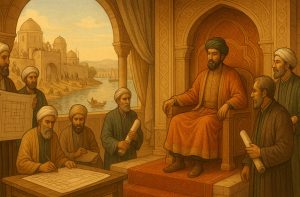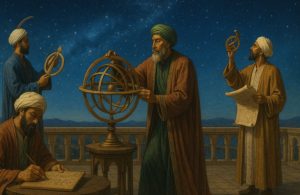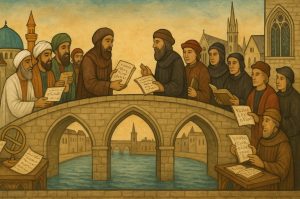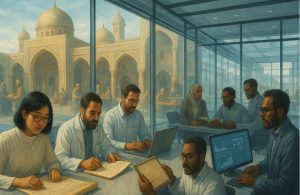What Made the House of Wisdom a Beacon of the Islamic Golden Age?
The House of Wisdom, known in Arabic as Bayt al-Hikmah, emerged as one of the most influential institutions of intellectual development during the Islamic Golden Age, a period of cultural, scientific, and economic flourishing that spanned from the 8th to the 13th century.
Located in Baghdad, the vibrant capital of the Abbasid Caliphate, the House of Wisdom was not just a library, it was a comprehensive research and academic centre that united scholars from across the known world.
The institution functioned at a time when much of Europe was engulfed in what is often referred to as the Dark Ages, making the House of Wisdom a rare and remarkable beacon of learning.
It became the catalyst for preserving and expanding ancient knowledge, ultimately bridging the classical world with the modern age.
How and Why Was the House of Wisdom Founded During the Abbasid Caliphate?

The foundation of the House of Wisdom was closely tied to the ambitions of the Abbasid dynasty to create a global centre for scholarship.
Under Caliph Harun al-Rashid (r. 786–809 CE), Baghdad was transformed into a cosmopolitan hub of art, commerce, and learning.
However, it was his son, Caliph Al-Ma’mun (r. 813–833 CE), who envisioned an institution that would unify knowledge across cultural boundaries.
Al-Ma’mun was deeply influenced by Greek philosophy and sought to integrate Hellenistic learning into the Islamic intellectual framework.
His reign saw the official establishment of the House of Wisdom as an institutional project where scholars could work full-time on translation, commentary, and original research.
The Abbasid court provided generous patronage, offering scholars salaries, housing, and tools to support their work.
Scholars from varying backgrounds Muslim, Christian, Jewish, Persian, and Indian were welcomed, making the House of Wisdom a unique site for interfaith and cross-cultural collaboration.
Why Was Translation Central to the House of Wisdom’s Mission?
Translation was the cornerstone of the House of Wisdom’s operations, and it became the launchpad for broader scientific and philosophical advancement.
The movement to translate Greek, Persian, Syriac, and Sanskrit texts into Arabic was not a simple act of linguistic conversion. It was a rigorous intellectual process that often included:
- Interpretation of complex ideas
- Commentary and critique
- Adaptation of foreign concepts into the Islamic worldview
This movement was largely supervised by scholars such as Hunayn ibn Ishaq, who directed translation efforts with an emphasis on accuracy and clarity. The scope of translation included works on:
| Subject | Key Authors Translated |
| Medicine | Galen, Hippocrates |
| Philosophy | Plato, Aristotle |
| Mathematics | Euclid, Pythagoras |
| Astronomy | Ptolemy |
| Natural Sciences | Various Greek and Persian sources |
These translations laid the groundwork for an explosion of original research in the centuries that followed. The works were copied, discussed, and preserved in libraries, ensuring that classical knowledge would not be lost to time.
What Were the Major Scientific and Mathematical Contributions?

One of the most striking features of the House of Wisdom was its ability not just to preserve knowledge but to advance it. Many key developments in science and mathematics that would later influence global scholarship had their origins here.
In mathematics, Al-Khwarizmi produced works that revolutionised the field. His book Al-Kitab al-Mukhtasar fi Hisab al-Jabr wal-Muqabala introduced algebra as a structured discipline, complete with methods for solving quadratic equations.
His work also introduced the decimal positional system, which replaced cumbersome Roman numerals in the West.
In astronomy, scholars such as Al-Battani refined the Ptolemaic model and developed more precise calculations of solar years and planetary orbits.
Their observations corrected several classical errors and were later used by astronomers like Copernicus.
Medicine also saw significant progress. Al-Razi (Rhazes) compiled encyclopaedic texts such as Kitab al-Hawi, covering diagnoses, treatments, and pharmaceutical compounds.
These texts were translated into Latin and became standard reference material in European medical schools.
A comparison of key contributions by discipline is outlined below:
| Field | Key Figure | Contribution |
| Mathematics | Al-Khwarizmi | Algebra, algorithms, decimal system |
| Astronomy | Al-Battani | Solar year calculations, trigonometric methods |
| Medicine | Al-Razi | Medical encyclopaedia, surgical techniques |
| Optics | Ibn al-Haytham | Light refraction, scientific method |
| Geography | Al-Idrisi | Detailed world maps and geographic descriptions |
How Did the House of Wisdom Foster Philosophy and Cultural Dialogue?
The House of Wisdom was equally vital in the field of philosophy. It served as a space where Greek philosophical traditions, particularly those of Plato and Aristotle, were integrated with Islamic theology.
The result was the birth of a unique intellectual movement that questioned the nature of existence, the soul, and divine justice.
Scholars such as Al-Farabi, Avicenna (Ibn Sina), and Al-Kindi explored ideas of metaphysics, logic, and ethics.
Their works were not only groundbreaking but also foundational for later Christian and Jewish philosophers such as Thomas Aquinas and Maimonides.
What set this institution apart was its pluralistic ethos. Muslim, Christian, and Jewish scholars worked together, discussing ideas openly without religious persecution.
This tolerance helped create a global intellectual language that transcended faith and geography.
In What Ways Did the House of Wisdom Influence the Renaissance?

The influence of the House of Wisdom extended far beyond the Islamic world. Through Andalusia (Spain) and Sicily, Arabic texts entered Latin-speaking Europe, particularly during the 12th century.
Institutions such as the Toledo School of Translators in Spain played a crucial role in this cultural transmission.
Texts on medicine, astronomy, philosophy, and mathematics were translated from Arabic into Latin, reintroducing Europe to the wisdom of the ancients, this time through the lens of Muslim scholars.
These texts were incorporated into the curricula of European universities and sparked renewed interest in empirical observation and rational thought.
The following table illustrates the flow of knowledge from the House of Wisdom to Europe:
| Phase | Region | Role in Knowledge Transfer |
| Preservation | Baghdad | Translation and enhancement of classical texts |
| Transmission | Spain, Sicily | Translation into Latin, dissemination to scholars |
| Transformation | Western Europe | Integration into university systems, Renaissance spark |
What Led to the Decline of the House of Wisdom and What Is Its Legacy?
Despite centuries of brilliance, the House of Wisdom met a tragic end in 1258 CE, when Mongol forces led by Hulagu Khan invaded Baghdad.
The city was pillaged, and its libraries, including the House of Wisdom, were destroyed. Thousands of irreplaceable manuscripts were lost, thrown into the Tigris River, which, according to legend, ran black with ink.
Yet, the intellectual legacy of the House of Wisdom remains profound and far-reaching. Its contributions laid the groundwork for the development of:
- Modern scientific methods
- University systems in Europe
- Medical practices and ethical philosophy
- Global academic collaboration
The House of Wisdom is often seen today as a model for international scholarly cooperation, where diversity of thought and mutual respect drive progress.
Why Is the House of Wisdom Still Relevant in Today’s World?

In the 21st century, where polarisation and misinformation often stifle progress, the House of Wisdom offers a timeless lesson: knowledge thrives where minds are open and diverse voices are welcomed.
Modern research institutions such as the CERN Laboratory or the MIT Media Lab function on similar principles of collaboration across cultures, disciplines, and ideologies.
Furthermore, digital archiving projects and open-access journals mirror the inclusiveness of the House of Wisdom’s intellectual mission.
Its story serves as a reminder that civilisations flourish not through conquest, but through curiosity, tolerance, and learning.
FAQs
What was the main purpose of the House of Wisdom?
Its primary goal was to translate, study, and expand upon classical knowledge, serving as a global centre for education and innovation.
Who established the House of Wisdom?
It was initiated by Caliph Harun al-Rashid and expanded by his son Caliph Al-Ma’mun during the Abbasid Caliphate.
How did the House of Wisdom influence modern science?
By preserving and advancing classical theories, it laid the intellectual foundations for the European Renaissance and modern scientific disciplines.
What made Baghdad the ideal location for the House of Wisdom?
Baghdad’s geographic position as a trade and cultural crossroads, combined with Abbasid support for scholarship, made it ideal for academic growth.
What types of texts were translated at the House of Wisdom?
Texts in philosophy, astronomy, medicine, mathematics, and natural science were translated from Greek, Syriac, Persian, and Sanskrit.
How did the House of Wisdom promote diversity and inclusion?
It welcomed scholars of various faiths and ethnicities, encouraging open dialogue and intellectual freedom.
What caused the destruction of the House of Wisdom?
The Mongol siege of Baghdad in 1258 led to the destruction of the House of Wisdom and its irreplaceable library.






